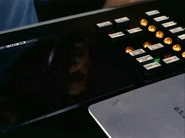(added notations) |
No edit summary |
||
| Line 10: | Line 10: | ||
From the transporter console, the transporter operator could also detect the presence of [[weapons]] or [[phaser]] fire within the transporter beam, and in some cases could deactivate the weapon before rematerialization. ({{TNG|The Most Toys}}) As yet another security feature, the console could also allow the operator to erect a [[force field]] around the transporter chamber. ({{TNG|Realm of Fear}}) |
From the transporter console, the transporter operator could also detect the presence of [[weapons]] or [[phaser]] fire within the transporter beam, and in some cases could deactivate the weapon before rematerialization. ({{TNG|The Most Toys}}) As yet another security feature, the console could also allow the operator to erect a [[force field]] around the transporter chamber. ({{TNG|Realm of Fear}}) |
||
| − | By the late 24th century, [[site-to-site transport]] became more commonplace and did not require a transporter console. Site-to-site transports could be activated by voice commands to the [[computer]] fairly easily. A site-to-site transport from a starship to another starship could also be done, from any console, such as a [[bridge]] station. The use of a bridge station to control transporter operations was a feature of some starship bridges in the [[23rd |
+ | By the late 24th century, [[site-to-site transport]] became more commonplace and did not require a transporter console. Site-to-site transports could be activated by voice commands to the [[computer]] fairly easily. A site-to-site transport from a starship to another starship could also be done, from any console, such as a [[bridge]] station. The use of a bridge station to control transporter operations was a feature of some starship bridges in the [[23rd century]] ({{VOY|Bliss}}, {{film|10}, {{film|2}}) |
''In one likely future, by the [[29th century]] the transporter pad has been moved to the bridge of [[timeship]]s such as [[Wells class|''Wells''-class]] ships, and was operated from bridge stations. ({{VOY|Relativity}})'' |
''In one likely future, by the [[29th century]] the transporter pad has been moved to the bridge of [[timeship]]s such as [[Wells class|''Wells''-class]] ships, and was operated from bridge stations. ({{VOY|Relativity}})'' |
||
| + | |||
| − | : |
+ | :The presence of a transporter platform on the bridge was part of the bridge set re-design done for the aborted Phase II tv series. The concept was not carried through to the set as re-built for the first motion picture.'' |
<gallery> |
<gallery> |
||
Revision as of 17:55, 4 September 2010
The transporter console is a component of the transporter system. Located in the transporter room, it manually controls the functions of the transporter and its maintenance. It is typically operated by the transporter chief or other operations division personnel.
Commonly seen aboard starships from the 22nd century all the way through the 24th century, the transporter console utilizes three sliding controls (either manual levers or touch sensitive panels) to achieve transporter function. (ENT: "Broken Bow") The console also allows the operator to monitor various functions of the transporter system, including pattern buffer operations, signal resolution and even matter stream contaminants. (TNG: "Violations", "Realm of Fear", "Relics")
From the transporter console, the transporter operator could also detect the presence of weapons or phaser fire within the transporter beam, and in some cases could deactivate the weapon before rematerialization. (TNG: "The Most Toys") As yet another security feature, the console could also allow the operator to erect a force field around the transporter chamber. (TNG: "Realm of Fear")
By the late 24th century, site-to-site transport became more commonplace and did not require a transporter console. Site-to-site transports could be activated by voice commands to the computer fairly easily. A site-to-site transport from a starship to another starship could also be done, from any console, such as a bridge station. The use of a bridge station to control transporter operations was a feature of some starship bridges in the 23rd century (VOY: "Bliss", {{film|10}, Star Trek II: The Wrath of Khan)
In one likely future, by the 29th century the transporter pad has been moved to the bridge of timeships such as Wells-class ships, and was operated from bridge stations. (VOY: "Relativity")
- The presence of a transporter platform on the bridge was part of the bridge set re-design done for the aborted Phase II tv series. The concept was not carried through to the set as re-built for the first motion picture.
- The purpose of the many settings and controls on the transporter console are as mysterious as the mechanism behind the transporter itself.
- During the making of "Where No Man Has Gone Before", Star Trek's production personnel reused the bridge helm console as the transporter console.


